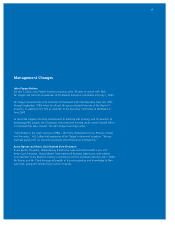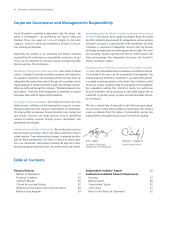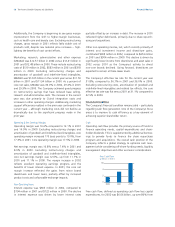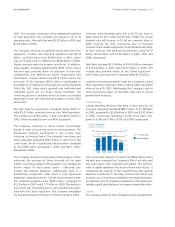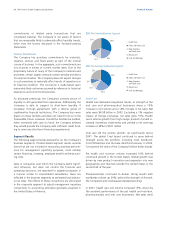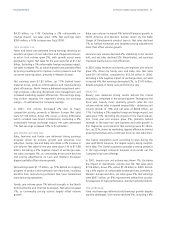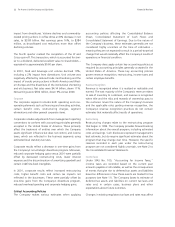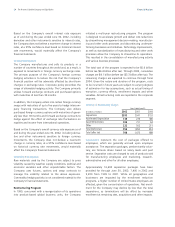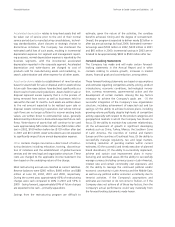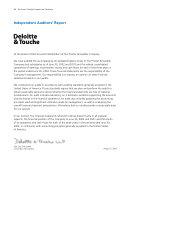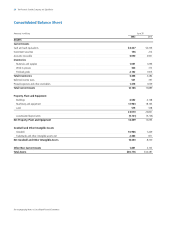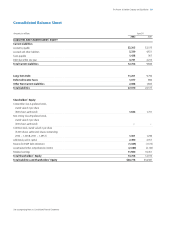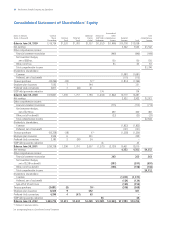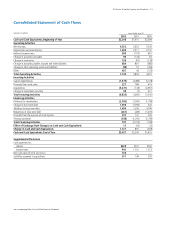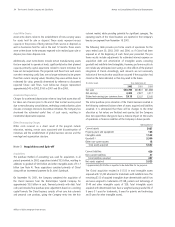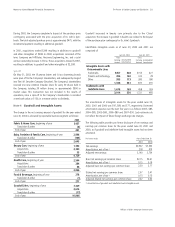Proctor and Gamble 2002 Annual Report Download - page 27
Download and view the complete annual report
Please find page 27 of the 2002 Proctor and Gamble annual report below. You can navigate through the pages in the report by either clicking on the pages listed below, or by using the keyword search tool below to find specific information within the annual report.Financial Review 25The Procter & Gamble Company and Subsidiaries
Accelerated depreciation relates to long-lived assets that will
be taken out of service prior to the end of their normal
service period due to manufacturing consolidations, technol-
ogy standardization, plant closures or strategic choices to
discontinue initiatives. The Company has shortened the
estimated useful lives of such assets, resulting in incremental
depreciation expense. For segment and management report-
ing purposes, normal depreciation expense is reported by the
business segments, with the incremental accelerated
depreciation reported in the corporate segment. Accelerated
depreciation and write-downs are charged to cost of
products sold for manufacturing assets and marketing, re-
search, administrative and other expense for all other assets.
Asset write-downs relate to establishment of new fair-value
bases for assets held for sale or disposal and for assets whose
future cash flow expectations have declined significantly as a
direct result of restructuring decisions. Assets held for sale or
disposal represent excess capacity that is in the process of
being removed from service as well as businesses held for
sale within the next 12 months. Such assets are written down
to the net amount expected to be realized upon sale or
disposal. Assets continuing in operation, but whose nominal
cash flows are no longer sufficient to recover existing book
values, are written down to estimated fair value, generally
determined by reference to discounted expected future cash
flows. Write-downs of assets that will continue to be used
were approximately $45 million before tax ($33 million after
tax) in 2002, $160 million before tax ($133 million after tax)
in 2001 and $0 in 2000. Asset write-downs are not expected
to significantly impact future annual depreciation expense.
Other contains charges incurred as a direct result of restruc-
turing decisions including relocation, training, discontinua-
tion of initiatives and the establishment of global business
services and the new legal and organization structure. These
costs are charged to the applicable income statement line
item based on the underlying nature of the charge.
Most restructuring accruals are classified as current liabilities.
Reserve balances were $245 million, $460 million and $88
million at June 30, 2002, 2001 and 2000, respectively.
During the current year, approximately 60% of restructuring
charges were cash compared to 40% in 2001 and 55% in
2000. Going forward, approximately 60% of future charges
are expected to be cash – primarily separations.
Savings from the restructuring program are difficult to
estimate, given the nature of the activities, the corollary
benefits achieved, timing and the degree of reinvestment.
Overall, the program is expected to deliver nearly $2 billion in
after tax annual savings by fiscal 2004. Estimated incremen-
tal savings were $700 million in 2002, $235 million in 2001
and $65 million in 2000. Incremental savings in 2003 are es-
timated to be approximately $400 to $500 million after tax.
Forward-Looking Statements
The Company has made and will make certain forward-
looking statements in the Annual Report and in other
contexts relating to volume growth, increases in market
shares, financial goals and cost reduction, among others.
These forward-looking statements are based on assumptions
and estimates regarding competitive activity, pricing, product
introductions, economic conditions, technological innova-
tion, currency movements, governmental action and the
development of certain markets. Among the key factors
necessary to achieve the Company’s goals are: (1) the
successful integration of the Company’s new organization
structure, including achievement of expected cost and tax
savings; (2) the ability to achieve business plans, including
growing volume profitably, despite high levels of competitive
activity, especially with respect to the product categories and
geographical markets in which the Company has chosen to
focus; (3) the ability to maintain key customer relationships;
(4) the achievement of growth in significant developing
markets such as China, Turkey, Mexico, the Southern Cone
of Latin America, the countries of Central and Eastern
Europe and the countries of Southeast Asia; (5) the ability to
successfully manage regulatory, tax and legal matters,
including resolution of pending matters within current
estimates; (6) the successful and timely execution of planned
brand divestitures; (7) the ability to successfully implement,
achieve and sustain cost improvement plans in manu-
facturing and overhead areas; (8) the ability to successfully
manage currency (including currency issues in Latin America),
interest rate and certain commodity cost exposures; and
(9) the ability to manage the continued political and/or
economic uncertainty in Latin America and the Middle East,
as well as any political and/or economic uncertainty due to
terrorist activities. If the Company’s assumptions and
estimates are incorrect or do not come to fruition, or if the
Company does not achieve all of these key factors, then the
Company’s actual performance could vary materially from
the forward-looking statements made herein.


